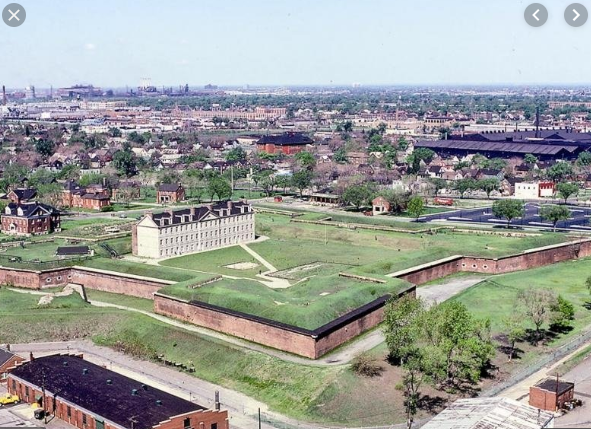Detroit officials this month said they will seek out concepts for the city-owned 78-acre riverfront park as they finalize a lengthy process to lift multiple deed restrictions that have limited the city’s ability to find new uses for the fort’s buildings that have endured decades of neglect.
The property in the Delray community in southwest Detroit is adjacent to the future entrance of the $4.4 billion Gordie Howe International Bridge, broadening exposure for the site.
The former military facility on West Jefferson contains an 1842 star fort, a fortress built to shoot cannons, prehistoric Native American burial mound and vacant buildings that, over time, have been used for residential, office and storage space.
The city is asking for concepts that could target individual buildings, a group or the entire site along the Detroit River, the request being distributed by the city’s General Services Department says.
The draft notes that the responses will be used to inform the city’s efforts “to facilitate new partnerships, recreational and historical programming, and adaptive uses” at Fort Wayne, and might lead to the selection of one or more partners.
Elliott said the city might opt to negotiate long-term leases for some of the buildings and bring on a third party to oversee operations. Developers selected for future projects will be responsible for infrastructure costs.
The National Park Foundation and Kresge Foundation are funding the city’s planning process. Kresge in 2016 announced the partnership and a $265,000 grant to support the effort.
“Kresge saw an opportunity for a comprehensive planning and engagement process that could lead to a valuable, underutilized historical and cultural asset becoming major benefits to Detroit, in particular, to the residents of southwest Detroit and local indigenous communities who have a connection to the site,” Wendy Lewis Jackson, managing director of the Kresge Detroit Program, said in a statement.
The city acquired Historic Fort Wayne in three phases in 1949, 1971 and 1976. Each came with unique land restrictions that range from a ban on picnic tables to sporting activities on certain portions of the grounds, Elliott said.
The city’s General Services Department is working to remove the deed restrictions within the year, opening potential opportunities.
As part of an advisory group for Fort Wayne, southwest Detroit resident Simone Sagovac wants to secure the fort’s long-term historic preservation and economic investment to keep it maintained. She’s open to improvements but wants to ensure they are inclusive of the community, rather than high-end developments that would primarily cater to an exclusive clientele.
“I have personal concerns about how that process could potentially open up to uses that maybe would not be in line with what community residents would want to see there,” said Sagovac, a member of the Southwest Detroit Community Benefits Coalition. “I want to make sure that there’s always going to be community voices in this process.”
The bridge project is elevating Fort Wayne to serve as a gateway to Detroit and the region. To account for that, the city is working on plans to increase public access by the end of the year.


